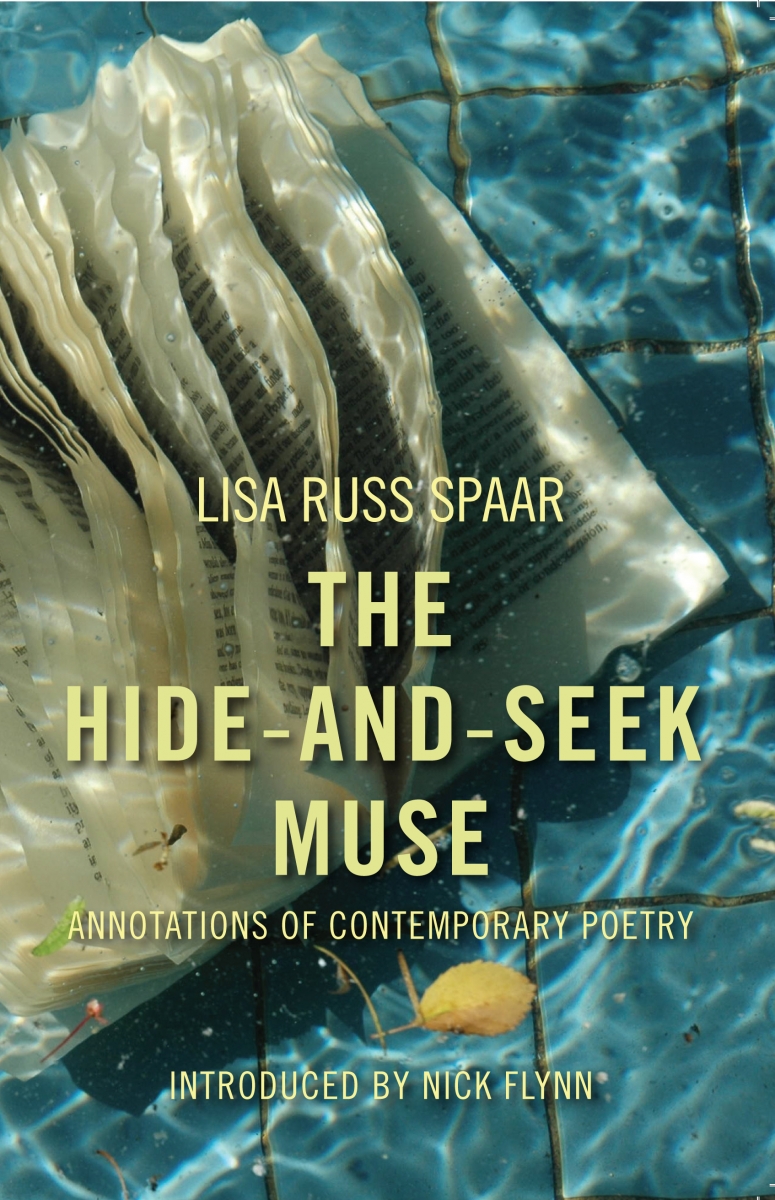- Art
- Fiction
- Non-Fiction
- Poetry
- Reviews
- The Hide & Seek Muse
- Allison Seay
- Amy Newman
- Brenda Hillman
- Claudia Emerson
- David Baker
- David Francis
- Debra Allbery
- Edward Hirsch
- Erika Meitner
- Jane Hirshfield
- Jennifer Chang
- Jennifer Key
- John Poch
- Kate Daniels
- Kiki Petrosino
- Kyle Dargan
- L. S. Klatt
- Laura Kasischke
- Mark Jarman
- Mary Ann Samyn
- Randall Couch
- Ravi Shankar
- Talvikki Ansel
- Test Entry Writer's Name
- Two Author Test
You are here
Lisa Russ Spaar
Some Musings on Using The Hide-and-Seek Muse

Lisa Russ Spaar
Drunken Boat Media, 2013
ISBN: 9780988241602
Purchase from SPD Books
It may be, as Dr. Williams said, “difficult / to get the news from poems,” perhaps because the kind of knowing poems impart has little to do with facts, data, or information gathering and dissemination but rather with the more complex, vexed language of the deep heart’s core. In The Gutenberg Elegies: The Fate of Reading in an Electronic Age, Sven Birkerts writes that books provide a “place of sanctuary. Not a physical place—not church or office—but a metaphysical one. Depth survives, condensed and enfolded, in authentic works of art.” I know that closely and passionately reading the poems in The Hide-and-Seek Muse, and writing about them for the Chronicle of Higher Education each week, afforded me something akin to the ulterior space Birkerts describes, and it occurs to me that the book might provide for readers, both those accustomed to engaging with poems and those who find poetry difficult, a similar zone of restoration, self-excavation, and linguistic discovery.
In the secondary or college classroom, for example, The Hide-and-Seek Muse offers students a glimpse into the formal, aesthetic, and thematic range of poetry being written in the second decade of our new millennium. The poems themselves are strikingly diverse and compelling, and represent emerging poets in their 20s as well as poets in their seventh and eighth decades. The commentaries model various modes of close reading, offering departure points as well as something to resist in class discussion. The essays about poetry that form the vertebral spine of the text place these manifold poems of our current moment in broader historical and cultural contexts.
It strikes me that writers groups or book clubs, which often shy away from poetry in favor of fiction and non-fiction, might find in this book a way to integrate poetry into the conversation. A week or two could be devoted to the text, with members choosing different poems and commentaries to discuss, or the book might be used over the course of a season or year, with each meeting starting off with a reading of one poem before the club members move on to the prose text at hand.
In his Introduction to The Hide-and-Seek Muse, Nick Flynn refers to the book as a kind of personal breviary: “Everything, it seems, is a daily practice, or at least everything that matters to me. I get the sense that this book in your hands could become part of a daily practice . . . could be a way to infuse poetry into every moment, or to simply reveal how it is already infused, if we can find the thresholds.” Portable enough to carry along or to heft while reading in bed or bath, The Hide-and-Seek Muse is the kind of book that lends itself to all manner of delving—a quick dip in to savor one poem, or a longer foray into a section on poetry and illness, or poetry and the seasons. The book is structured to reward what Anne Carson would call the dabbling, “promiscuous reader” as well as the reader who wants to read from start to finish.
However readers “use” The Hide-and-Seek Muse, I hope that the marvelous poems it gathers and curates move them with even a fraction of the gracious force they have been and continue to be for me.
Lisa Russ Spaar
Lisa Russ Spaar is the author of many collections of poetry, including Glass Town (Red Hen Press, 1999), Blue Venus (Persea, 2004), Satin Cash (Persea, 2008) and most recently Vanitas, Rough (Persea, December 2012). She is the editor of Acquainted with the Night: Insomnia Poems and All that Mighty Heart: London Poems, and a collection of her essays, The Hide-and-Seek Muse: Annotations of Contemporary Poetry just appeared from Drunken Boat Media. Her awards include a Guggenheim Fellowship, a Rona Jaffe Award, the Carole Weinstein Poetry Prize, an Outstanding Faculty Award from the State Council of Higher Education for Virginia, and the Library of Virginia Award for Poetry. Her poems have appeared in the Best American Poetry series, Poetry, Boston Review, Paris Review, Ploughshares, Slate, Shenandoah, The Kenyon Review, Virginia Quarterly Review, and many other journals and quarterlies, and her commentaries and columns about poetry appear regularly or are forthcoming in The Chronicle of Higher Education, the Washington Post, the New York Times, the Los Angeles Review of Books, and elsewhere. She is a professor of English and Creative Writing at the University of Virginia.
Donate
Without your support Drunken Boat could not exist. Please Donate Today.
Social-ize
Copyright © 2017 — Drunken Boat 17